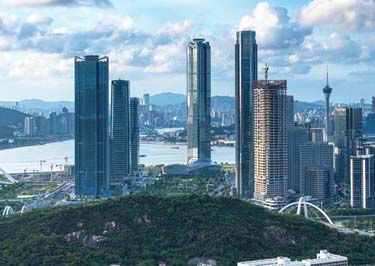Doumen Small Haochong, former hustling and bustling small Macao
Small Haochong Village in Doumen District is home to 251 traditional Guangfu dwellings, a once-booming commodity distribution center known as Small Macao, and 300-year-old Kwong (Kuang) Ancestral Hall, which was bestowed by the Song Dynasty's 11th Emperor Hsiao-tsung (Xiaozong) (1127 - 1194).
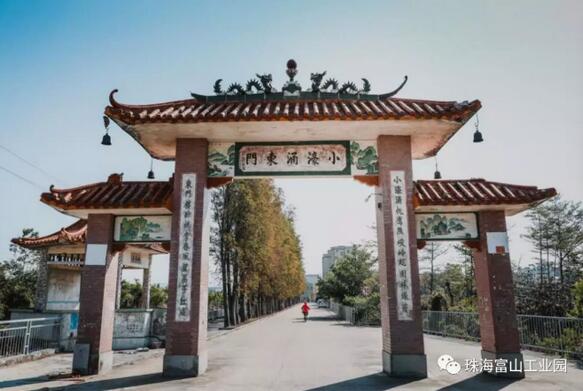
Gateway to Small Haochong Village
7-century-old Small Haochong
Situated southwest of Doumen Town, the 12-sq-km village had a registered population of 7,400 as of 2018. An abundance of oysters (shēngháo) inhabited a brook of fast-running water (chōng), giving the village name Haochong.
During 1437, the second year of the reign of Emperor Zhengtong of the Ming Dynasty (1368-1644), the community came into being when Pinglin, second-son of Doumen Village founder Kwong (Kuang) Juchuang, led his family clan to reside there.
Small Macao
It was the only channel through which Chinese laborers from Doumen headed for jobs in Europe, the Americas, and Southeast Asia by water. As such, the now-150-year-old Haoxi Wharf witnessed a thriving period for Small Haochong Village. Three liners set out daily for Macao, Jiangmen, and Shiqi in what is today Zhongshan.
Store-lined streets packed with businesspeople buying and selling wholesale from neighboring areas earned it the nickname Small Macao due to hustle and bustle at the commodity distribution center.
Between March and May 1950, more than 100 fishing boats set sail from there carrying PLA troops to fight for the liberation of Hainan across the Qiongzhou Strait in Guangdong to the Leizhou Peninsular.
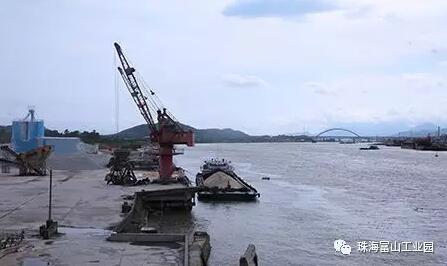
Haoxi Wharf
Guangfu dwellings
Still in existence are 251 Guangfu dwellings, typical traditional houses mainly distributed in the Greater Pearl River Delta and western Guangdong areas, and ten ancestral halls.
Cultural relics also include the site of Jianmin Elementary School that was started in 1936, Kuang Anle and Kuang Boqian family shrines constructed in the Qing Dynasty (1644-1911), and Kuang Zhongxing Shrine built during the Republic of China period.
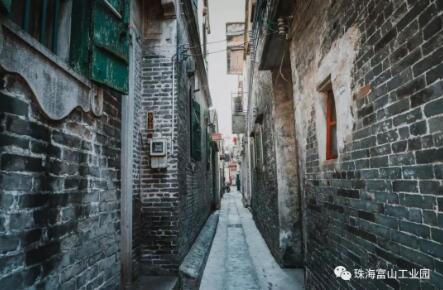
Lane between two lines of Guangfu dwellings
Emperor-bestowed Kwong (Kuang) Ancestral Hall
The most sparkling monument among 10 such structures is Kwong (Kuang) Ancestral Hall bestowed by Emperor Hsiao-tsung (Xiaozong) (1127 - 1194) of the Song Dynasty (reigned 1163-89).
Research shows that during the reign of Emperor Hsiao-tsung, the Kuang forefather’s daughter Shuli was appointed as an imperial concubine. As an act of royal graciousness, the emperor issued a decree to her father to construct the palatial eight-column shrine. But the drawings on paper were lost and regained during continuous warfare, and then begun to be brought to life 300 years later. At last, the ancestral hall was completed in 1725 -- the third year of the reign of Emperor Yung-cheng (Yongzheng) (1678-1735) in the Qing Dynasty.
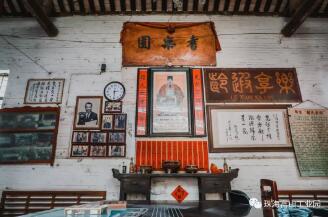
Main hall of Kwong (Kuang) Ancestral Hall
The neat and solemn hall has two tiers and eight pillars. The imperial edict is inscribed on the folding screen at the center of the entryway and drum platforms are set on each side of the gate. On the doorframe of the façade are eight vivid embossed golden dragons.
In width of 13.2 m (43 ft) and front-to-back length of 23 m (75.5 ft), the 474-sq -m (5,102-sq-ft) ancestral hall is a fusion of northern post-and-lintel with southern column-and-tie building methods. It encompasses the first-tier three rooms from the hallway and three-room five tiers in the back. Featuring a flush gable roof and antique ridge, the building has a sandstone-based gray-brick wall in front, rammed-earth gable and back walls, and a 20-m (65.6-ft) long by 3.8-m (12.5-ft) tall outer wall comprised of oyster shells on the right. On the head of the granite doorframe hangs a horizontal plaque etched with Kuang Shi Zong Ci -- Kwong (Kuang) Ancestral Hall. The courtyard contains a well.
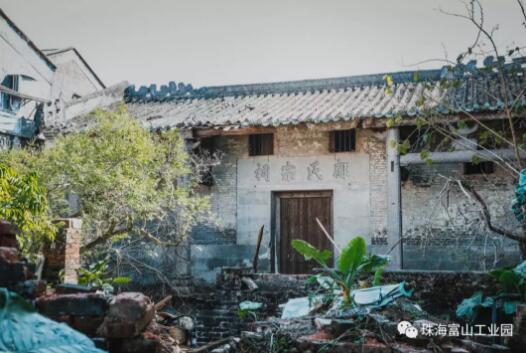
Kwong (Kuang) Great Ancestral Hall [Photos courtesy Zhuhai Fushan Industrial Park ID: zhfsgyy]
Kwong (Kuang) Family
Documents state that the Kuang Family are descendants of Kuang Yisheng who lived in Pan Village of Kaiping Town in Jiangmen City -- around 88 km (56 miles) from Zhuhai. Tenth-generation Kuang Juchuang relocated his four sons to Doumen in around 1431 in the Ming Dynasty.
The Kuang Family now has more than 2,000 descendants in the US, United Kingdom, Australia, Cuba, and other countries. The family tree includes 13 Qing government officials through imperial examination. A daughter, Kuang Congqing, wife of Huang Huaisen -- Guangxi governor in the late Qing Dynasty -- was bestowed the title of Imperial Mandate of the First Degree by Emperor Kuang-Hsu (Guangxu) for successfully assisting her husband, becoming the first such woman to win the honor in Doumen history.
Kwong Yau Leung (Kuang Youliang), or Hiram Leong Fong, born Yau Leong Fong (Oct 15, 1906 to Aug 18, 2004), was an elder statesman and business tycoon industrialist from Hawaii. He is most noted for service as a Republican US senator from 1959 to 1977, the first Asian American and Chinese American to be elected as such. In 1964, Fong became the first Asian American to seek the party's nomination for president of the United States. For a long time, he was the only Republican to ever have held a senate seat from Hawaii.
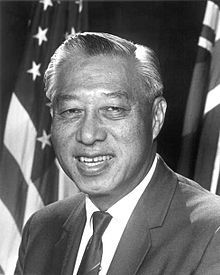
Kwong Yau Leung (Kuang Youliang) [Photo courtesy peoplemaven.com)
Another local celebrity was renowned writer Kuang Jinbi, author of the famous Chinese fable The Magic Ox and Other Tales of the Effendi. Hong Kong female pop star Cally Kwong (Kuang Meiyun) also was born in the village.


